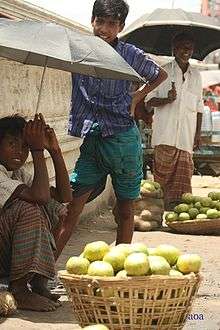Citrus macroptera
| Citrus macroptera | |
|---|---|
 | |
| Shatkora sellers in Sylhet, Bangladesh | |
| Scientific classification | |
| Kingdom: | Plantae |
| (unranked): | Angiosperms |
| (unranked): | Eudicots |
| (unranked): | Rosids |
| Order: | Sapindales |
| Family: | Rutaceae |
| Genus: | Citrus |
| Subgenus: | Papeda |
| Species: | C. macroptera |
| Binomial name | |
| Citrus macroptera Montrouz. | |
| Synonyms[1] | |
| |
Citrus macroptera with English common names Melanesian papeda,[1] wild orange,[2] cabuyao or satkara[3] is a semi-wild species of citrus native to Malesia and Melanesia.[2]
Some authorities consider C. macroptera to be a taxonomic synonym of C. hystrix (kaffir lime),[4] while others consider C. macroptera var. annamensis to be a synonym of C. hystrix, but not C. macroptera var. macroptera.[5]
Description
Citrus macroptera is so-named because of the large "wings" (-ptera) on the petiole, which is as large as the blade of the leaf.[2] The tree, which has thorns, can reach 5 m in height. Its fruit is about 6–7 cm in diameter, has a fairly smooth, moderately thick rind, and is yellow when ripe. The pulp of the fruit is greenish yellow and dry (does not produce much juice). The juice is very sour, and somewhat bitter.[2]
Varieties
The species is sometimes divided into four varieties, or alternatively into three separate species, as follows:[5]
- C. macroptera var. macroptera
- C. macroptera var. annamensis Tanaka -> C. combara Raf.
- C. macroptera var. combara (Raf.) Tanaka -> C. combara Raf.
- C. macroptera var. kerrii Swingle -> C. kerrii (Swingle) Tanaka
Cultivation
A cultivar of C. macroptera var. annamensis known as 'Sat Kara',[6] is grown primarily in the Sylhet Division of northeastern Bangladesh where it is called "hatkora" or "shatkora" (Sylheti: ꠢꠣꠔ꠆ꠇꠞ Bengali: সাতকরা).
Uses
Culinary uses
In Bangladesh the rind of the Citrus macroptera is eaten as a vegetable, while the pulp is usually discarded because of its bitter-sour taste. It has a unique taste and aroma. The thick rind is cut into small pieces and cooked; either green or ripe, in beef, mutton, and fish curries, as well as in stews. The fruit is also a primary ingredient in satkora/shatkora pickles. Curries cooked with shatkora and beef or mutton is now served in many Bangladeshi/Indian restaurants in the UK. A beef shatkora dish cooked by local chefs in Bangladesh is featured in the British chef Rick Stein's cookery programme Rick Stein's Far Eastern Odyssey (in Episode 6), which was broadcast by the BBC on 20 August 2009.
Medicinal uses
This plant is used medicinally locally in Assam.[6]
Perfumery
Many of the C. macroptera var. annamensis fruits are exported from Bangladesh, exacting a high price because their oil is used in the perfume industry.[6]
See also
- Bangladeshi cuisine
- Citrus latipes a similar-looking species native to Northeast India
References
- 1 2 "Citrus macroptera information from NPGS/GRIN". ars-grin.gov.
- 1 2 3 4 Harley I. Manner, Richard S. Buker, Virginia Easton Smith, Deborah Ward, and Craig R. Elevitch 2006. Species profiles for Pacific Island agroforestry: Citrus (citrus) and Fortunella (kumquat), Rutaceae (Rue family). pdf
- ↑ Peter Hanelt (ed.) 2001 Mansfeld's encyclopedia of agricultural and horticultural crops (except ornamentals), first English edition. Springer. in Google Books
- ↑ "TPL, treatment of Citrus hystrix DC.". The Plant List; Version 1. (published on the internet). Royal Botanic Gardens, Kew and the Missouri Botanical Garden. 2010. Retrieved March 9, 2013.
- 1 2 Porcher Michel H. et al. 1995–2020 (2007). Sorting Citrus Names: Multilingual Multiscript Plant Name Database (M.M.P.N.D) - A Work in Progress. School of Agriculture and Food Systems. Faculty of Land & Food Resources. The University of Melbourne. Australia.
- 1 2 3 M. N. Miah, Sahina Islam, and Syed Hadiuzzaman 2002. Regeneration of plantlets through somatic embryogenesis from nucellus tissue of Citrus macroptera Mont. var. anammensis (‘Sat Kara’). Plant Tissue Culture and Biotechnology 12(2):167-172 pdf